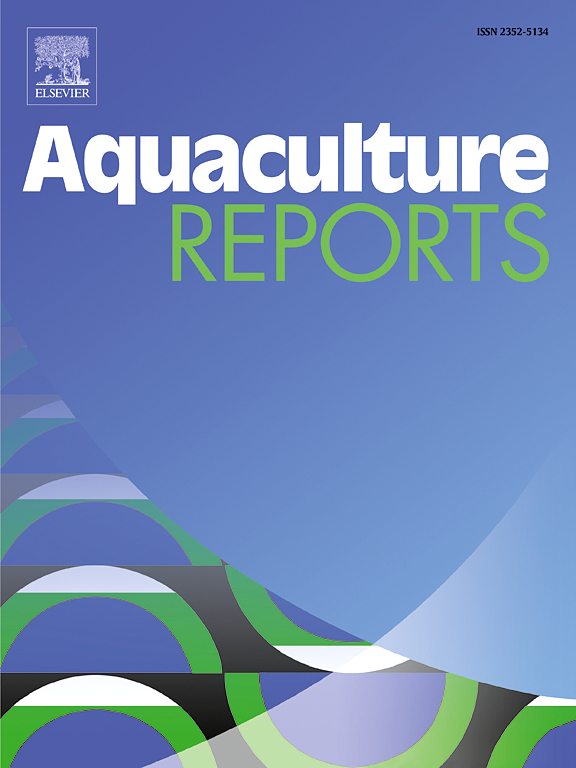Mechanisms of Amomum villosum essential oil in enhancing tilapia (Oreochromis niloticus) intestinal health
IF 3.2
2区 农林科学
Q1 FISHERIES
引用次数: 0
Abstract
Amomum villosum is a member of the ginger family to treat gastrointestinal diseases in humans. Supplementing the diet of tilapia (Oreochromis niloticus) with essential oil (EOA) can enhance digestive and intestinal antioxidant capacity. We conducted a comparative experiment using tilapia to further understand the potential molecular response mechanism to dietary EOA. Fish were divided into four groups with different feeding doses of EOA: L (2 g/Kg) group, M (4 g/Kg) group, and H (8 g/Kg) group, along with a control group without EOA supplementation. The level of inflammatory factors (TNF-α, IL-1) declined significantly in the EOA group. Comparative transcriptome of the intestines revealed differentially expressed genes (DEGs) in each group, which further revealed that enriched terms were closely related to important pathways such as PI3K-Akt signaling, cell adhesion molecules, regulation of actin cytoskeleton, and autoimmune thyroid disease. These pathways play significant roles in regulating various cellular processes and immune responses of intestines. Intestine metabolomic analysis indicated that dietary EOA caused changes in metabolic processes, particularly in nucleotide metabolism, indicating the potential impact of EOA on these processes. To identify key factors regulating the molecular response to EOA supplementation, a weighted gene co-expression network analysis combined with transcriptome and differential metabolites to identify key genes and metabolites. Glycitein and genistein are substances related to the metabolism of soybean meal were identified. Hmgb2, Parp11, Bcoll is considered to be the key genes, and has the immune regulation function. This study provides new insights into the molecular basis underlying the protective effects of dietary EOA in tilapia. The results can benefit the aquaculture industry by developing dietary strategies to improve the health and welfare of tilapia in intensive farming.
Amomum villosum 精油增强罗非鱼(Oreochromis niloticus)肠道健康的机制
Amomum villosum 是姜科植物,可治疗人类的胃肠道疾病。在罗非鱼(Oreochromis niloticus)膳食中添加精油(EOA)可提高消化系统和肠道的抗氧化能力。我们利用罗非鱼进行了一项比较实验,以进一步了解膳食 EOA 的潜在分子反应机制。我们将罗非鱼分为四组,分别投喂不同剂量的 EOA:L组(2 g/Kg)、M组(4 g/Kg)和H组(8 g/Kg),以及未添加EOA的对照组。EOA组的炎症因子(TNF-α、IL-1)水平明显下降。肠道转录组比较显示了各组的差异表达基因(DEGs),进一步发现富集的术语与重要通路密切相关,如 PI3K-Akt 信号、细胞粘附分子、肌动蛋白细胞骨架调节和自身免疫性甲状腺疾病。这些通路在调节肠道的各种细胞过程和免疫反应中发挥着重要作用。肠道代谢组学分析表明,膳食中的环氧乙烷会引起代谢过程的变化,尤其是核苷酸代谢的变化,这表明环氧乙烷对这些过程有潜在的影响。为了确定调节补充 EOA 分子反应的关键因素,加权基因共表达网络分析结合转录组和差异代谢物确定了关键基因和代谢物。鉴定出了与豆粕代谢有关的物质--亚甘氨酸和染料木素。Hmgb2、Parp11、Bcoll被认为是关键基因,具有免疫调节功能。本研究为了解膳食 EOA 对罗非鱼保护作用的分子基础提供了新的视角。研究结果可为水产养殖业带来益处,有助于制定日粮策略,改善集约化养殖罗非鱼的健康和福利。
本文章由计算机程序翻译,如有差异,请以英文原文为准。
求助全文
约1分钟内获得全文
求助全文
来源期刊

Aquaculture Reports
Agricultural and Biological Sciences-Animal Science and Zoology
CiteScore
5.90
自引率
8.10%
发文量
469
审稿时长
77 days
期刊介绍:
Aquaculture Reports will publish original research papers and reviews documenting outstanding science with a regional context and focus, answering the need for high quality information on novel species, systems and regions in emerging areas of aquaculture research and development, such as integrated multi-trophic aquaculture, urban aquaculture, ornamental, unfed aquaculture, offshore aquaculture and others. Papers having industry research as priority and encompassing product development research or current industry practice are encouraged.
 求助内容:
求助内容: 应助结果提醒方式:
应助结果提醒方式:


